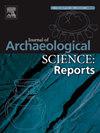Dental evidence of textile-related task activities in the Bronze Age site of Laderas del Castillo (Alicante, Spain)
IF 1.5
2区 历史学
0 ARCHAEOLOGY
引用次数: 0
Abstract
The burial 7 from the Argaric site of Laderas del Castillo (Alicante, Spain), dating from the 2nd millennium BC, included a skeleton associated with a carinated vessel indicative of social recognition. Anthropological and DNA-based methods were combined to determine that the individual corresponds to a young female. Macro- and scanning microscopic analyses revealed morphologically uniform labial notches with smooth and polished enamel on maxillary central incisors, which suggest tooth-tool use involving craft tasks. Plant fibers entrapped in dental calculus suggest that the individual was involved in textile and craft production, most likely working with flax or hemp. These findings provide new and direct insights into the use of teeth as tools related to crafts involving threads and are valuable for assessing the social division of labor within the Argaric prehistoric populations from Southeastern Iberia.
拉德拉斯-德尔卡斯蒂略青铜时代遗址(西班牙阿利坎特)中与纺织相关活动的牙齿证据
拉德拉斯德尔卡斯蒂略阿尔加里克遗址(西班牙阿利坎特)出土的 7 号墓葬可追溯到公元前两千年,其中包括一具骸骨和一个刻有刻痕的器皿,这表明了社会对该骸骨的认可。人类学和 DNA 方法相结合,确定该骸骨为年轻女性。宏观和扫描显微镜分析表明,上颌中切牙上有形态一致的唇形凹槽,珐琅质光滑锃亮,这表明使用牙具从事手工艺工作。牙结石中夹杂的植物纤维表明,该个体参与了纺织品和工艺品的生产,很可能使用亚麻或大麻。这些发现提供了关于使用牙齿作为与涉及线的工艺有关的工具的新的直接见解,对于评估伊比利亚东南部阿尔加里克史前人群的社会分工非常有价值。
本文章由计算机程序翻译,如有差异,请以英文原文为准。
求助全文
约1分钟内获得全文
求助全文
来源期刊

Journal of Archaeological Science-Reports
ARCHAEOLOGY-
CiteScore
3.10
自引率
12.50%
发文量
405
期刊介绍:
Journal of Archaeological Science: Reports is aimed at archaeologists and scientists engaged with the application of scientific techniques and methodologies to all areas of archaeology. The journal focuses on the results of the application of scientific methods to archaeological problems and debates. It will provide a forum for reviews and scientific debate of issues in scientific archaeology and their impact in the wider subject. Journal of Archaeological Science: Reports will publish papers of excellent archaeological science, with regional or wider interest. This will include case studies, reviews and short papers where an established scientific technique sheds light on archaeological questions and debates.
 求助内容:
求助内容: 应助结果提醒方式:
应助结果提醒方式:


